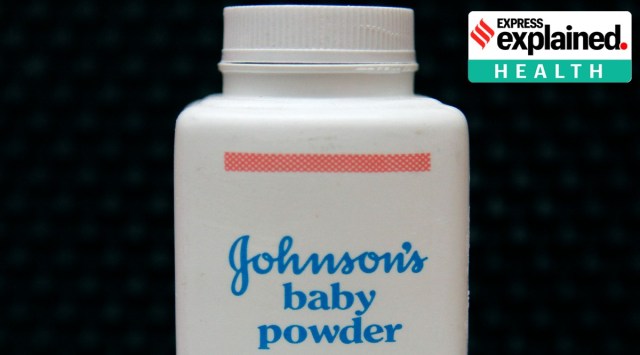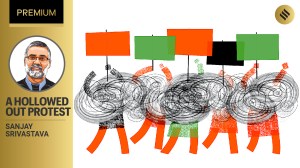- India
- International
Explained: Why has Johnson and Johnson decided to discontinue its talc-based baby powder?
Johnson and Johnson has announced that it will discontinue the sale of its talc-based baby powder globally in 2023. What is the reason for this? What were the lawsuits against J&J? Is the product safe to use?
 A bottle of Johnson's baby powder is displayed in San Francisco. (AP file photo)
A bottle of Johnson's baby powder is displayed in San Francisco. (AP file photo)Pharmaceutical giant Johnson and Johnson (J&J) announced Thursday (August 11) that it would discontinue the sale of its talc-based baby powder globally in 2023, amidst the tens of thousands of lawsuits from women who claim that the product caused them to have ovarian cancer, due to the alleged contamination of asbestos, a known carcinogen.
The announcement comes more than two years after J&J discontinued the product in the US and Canada. The company stated that it had made a “commercial decision” to transition to a cornstarch-based baby powder.
For years the company has maintained that the product is safe, which was reiterated on Thursday. “Our position on the safety of our cosmetic talc remains unchanged,” it said in a statement. Citing decades of independent scientific analysis by medical experts, J&J confirmed that its talc-based JOHNSON’S® Baby Powder is safe, does not contain asbestos, and does not cause cancer.”
What is talc?
Talc is the softest known mineral and is mined from underground deposits. Chemically, it is hydrous magnesium silicate, according to the US Food & Drug Administration (FDA), and is used in a variety of cosmetic and personal care products, like baby powder, lipstick, eyeshadow and foundation. When reduced to a fine powder, it is able to absorb moisture and reduce friction which keeps the skin dry, helps prevent rashes, stops makeup from caking and generally helps improve the feel and texture of a product.
Does it cause cancer?
Asbestos, the name for another group of naturally occurring silicate minerals, can also be found near talc deposits. According to the FDA, “there is the potential for contamination of talc with asbestos.” Asbestos has been used in construction and manufacturing, and is known to cause lung cancer, ovarian cancer, mesothelioma and other health conditions.

According to the American Cancer Society, it is generally accepted that talc contaminated with asbestos can cause cancer. However, it is less clear whether asbestos free talc is harmful as well. Since the 1960s, it has been suggested that when applied to the genital area or on sanitary napkins, talcum powder can cause ovarian cancer. However, the FDA states, “These studies have not conclusively demonstrated such a link, or if such a link existed, what risk factors might be involved.”
For decades, pediatricians have advised parents to not use talcum powder on babies, even if it does not contain asbestos. They warn that if they inhale talc, it can cause choking, infection and respiratory illnesses.
The lawsuits against Johnson and Johnson
In 1894, the company began selling the baby powder to alleviate diaper rash, and with its signature fragrance, has become recognizable across the world.
From the late 1990s, J&J has faced countless lawsuits over the alleged asbestos contamination of its baby powder, charges that the company has consistently denied. Darlene Coker was perhaps the first person to sue, claiming that the poisonous talc that she had used on her baby and herself had given her mesothelioma, a cancer that affects the tissue on various organs. During the hearing, J&J was able to avoid disclosing talc test results and internal company records that had been requested, and Coker was forced to drop the lawsuit, according to a Reuters report from 2018.
Since then, tens of thousands of lawsuits have been filed against J&J, on charges that its talcum powder was contaminated with cancer causing asbestos. It faces over 40,300 lawsuits in the US alone, as Bloomberg reported, and has been ordered to pay $3.5 billion in settlements so far.
In 2018, a jury in a Missouri court awarded $4.7 billion to 22 women, after it found that J&J’s talc products contained asbestos and contributed to their ovarian cancer, as reported by the Associated Press in 2021. A state appeals court dropped two women from the suit that year and reduced the award to $2 billion. Despite appeals by J&J, the Supreme Court did not overturn the verdict.
Investigations by Reuters and The New York Times in 2018, revealed that since the early 1970’s, J&J knew that their talc products were sometimes contaminated by small amounts of asbestos. After examining internal documents, the agencies claimed that executives at the company were concerned about a potential government ban and public backlash, all while refusing to disclose the information.
J&J refuted these claims and insisted that regular testing had shown that their baby powder was asbestos free.
What steps has Johnson and Johnson taken?
Despite repeated disavowal, in October 2019, J&J recalled 33,000 bottles of baby powder after the FDA found trace amounts of asbestos in one bottle. Later that month, the company said that 15 new tests from the same bottle conducted by laboratories that J&J hired found no asbestos, as reported by CBS News in 2020.
In May 2020, J&J announced that it would discontinue the sale of talc-based baby powder in Canada and the US, because of changing consumer habits “fueled by misinformation around the safety of the product and a constant barrage of litigation advertising”. They maintained that decades of studies had supported the safety of baby powder.
In response to the tens of thousands of lawsuits mounted against the company, J&J used a bankruptcy strategy known as the “Texas two-step” to limit the court ordered payouts, as reported by NPR.
Last October, J&J created a subsidiary in Texas called LTL Management LLC. It then transferred all baby powder claims and future liabilities into the new company, while keeping its assets separate. LTL subsequently filed for bankruptcy, which according to NPR put all the lawsuits against it on hold.
J&J executives have defended the controversial move, claiming that it would resolve the claims in an efficient and equitable manner. The lawyers of cancer patients that are suing J&J argue that the strategy is meant to delay and frustrate lawsuits that would have gone to a jury trial against the company directly, as reported by Forbes.
On September 19, an appeals court in Philadelphia will hear arguments by the lawyers of former talc users, as reported by Bloomberg, who argue that the bankruptcy filing by J&J was in “bad faith” because the litigation had not threatened the company’s overall financial position.
More Explained
EXPRESS OPINION
May 11: Latest News
- 01
- 02
- 03
- 04
- 05









































